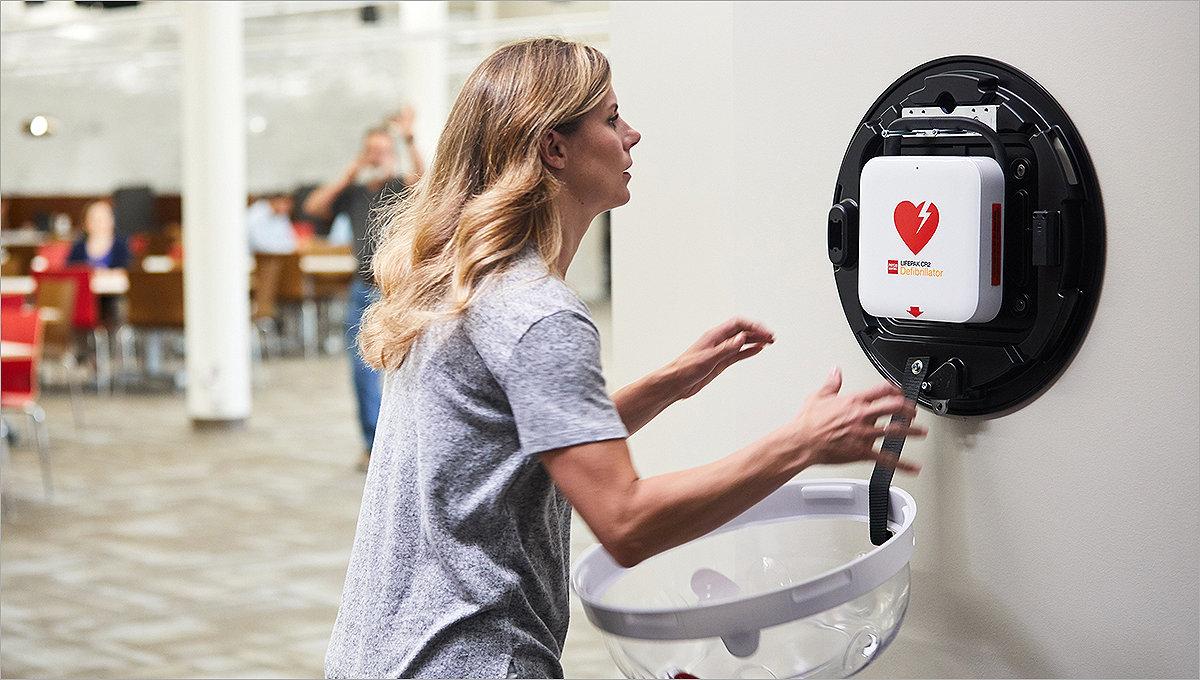14-Jul-2022
2-minute read
A workplace emergency is an unforeseen event that can endanger your employees or customers. These incidents can disrupt or shut down your operations and cause physical or environmental damage to your property. While you can never be fully prepared for every emergency, developing a plan of action prior to a possible emergency is key to responding in a timely and appropriate manner.
Emergencies may be either natural or manmade. While the list is long on possible scenarios, we believe preparing for a sudden cardiac emergency in your workplace is key to providing potentially lifesaving care.
What is sudden cardiac arrest
Sudden cardiac arrest is a leading cause of death in the United States. More than 350,000 out-of-hospital sudden cardiac arrests happen per year in the United States alone.1
Sudden cardiac arrest can occur when an electrical malfunction causes the heart to stop. This prevents the heart's ability to supply blood to the brain, lungs and other organs, causing death within minutes.
How to respond to a sudden cardiac emergency
While the survival rate for sudden cardiac arrest is less than 12 percent, there are actions bystanders can take within the first few minutes to help the possibility of saving a life.2
1. Call 911 for emergency medical services
2. Begin CPR immediately
3. Locate and begin using an automated external defibrillator (AED) as soon as possible
4. Continue CPR until first responders arrive
Performing high-quality cardiopulmonary resuscitation (CPR) on someone experiencing sudden cardiac arrest while waiting for an AED to arrive at the scene can help improve the chance of survival.
How an AED can help with sudden cardiac arrest
AEDs are lightweight, portable devices designed to save people experiencing sudden cardiac arrest in a public setting and can be used on children, teens and adults. Even bystanders can operate them by following audible and visual instructions during an emergency. An AED is a critical link in the chain of survival, empowering you to deliver possible lifesaving intervention prior to EMS arrival.
A sudden cardiac arrest victim's chance of survival decreases by seven to 10 percent for every minute without defibrillation.3 This is why it’s critically important for your organization to supply readily accessible AEDs throughout your building(s). AEDs should be located in highly visible areas and be within easy reach of individuals in a wheelchair. AEDs are stored in AED cabinets which should be mounted in an unobstructed area no more than 48 inches above the floor.
How to choose the right AEDs for your organization
There’s a wide array of AEDs available and choosing the best for your organization can be confusing. We recommend focusing on the following to find the correct AED for your needs:
1. Ease of use - AEDs should have simple graphics, audible instructions and automated features that help users remain calm and focused during a response.
2. Readiness - Know your AEDs are always charged and working
3. Connectivity and technology - An AED’s integrated Wi-Fi connectivity can give emergency responders a view into each cardiac arrest.
4. Affordability - Beyond the initial cost of the AED, consider long-term maintenance and accessory
5. Size and durability - Check for an IP56 rating, which is the industry's highest level of protection against dust and water in AEDs.
To learn more about how to choose the best AED, read our AED buying guide.
Together, we save lives
Help keep your workplace safe with Stryker’s full line of defibrillators. With the right solution for all public places, we can help improve SCA survival rates in your community.
Contact an AED expert today to learn more about your device options and how they can help your organization.
Learn more
- Benjamin EJ, Virani SS, Callaway CW, Chamberlain AM, Chang AR, Cheng S, et al. Heart disease and stroke statistics—2018 update: a report from the American Heart Circulation. 2018;137(12): e67-e492.
- American Heart Association (2018, June 22). CPR is key to survival of sudden cardiac arrest. www.heart.org https://www.heart.org/en/news/2018/07/12/cpr-is-key-to-survival-of-sudden-cardiac-arrest
- Cummins R.O. 1989. From concept to standard-of-care? Review of the clinical experience with automated external defibrillators. Annals of Emergency Medicine. 18: 1269-75.
Stryker Corporation or affiliated entities own, use or have applied for the trademarks or service marks, Power- LOAD, Power-PRO, Stryker. All other trademarks are trademarks of their respective owners or holders. The absence of a productor service name or logo from this list does not constitute a waiver of Stryker's trademark or other intellectual property rights concerning that name or logo.
Copyright © 2022 Stryker. Do not copy, reproduce, distribute, publish, modify, create derivative works, transmit, or exploit the copyrighted materials without prior permission from Stryker.
M0000008311 REV AA

